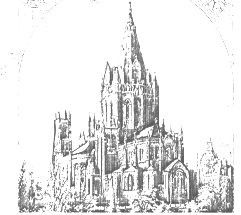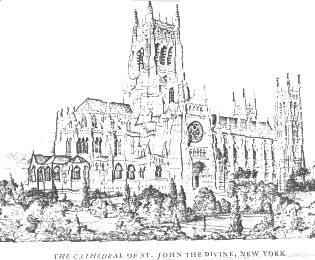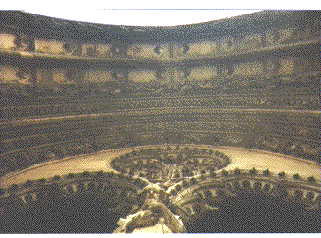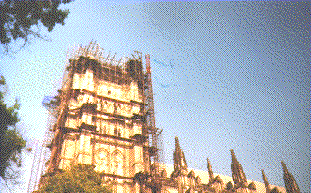|
The Cathedral Church of St. John the Divine
General History
| Beginnings
Although the concept of the Cathedral Church of St. John the Divine was first formulated around 1828, it only obtained official recognition when Rt. Rev. Horatio Potter, Bishop of New York, proposed the idea at the Diocesan Convention of 1872. The proposal received unanimous support. The New York state legislature granted a charter for the Cathedral in 1873 and fourteen years later, Bishop Potter and the Cathedral Trustees approved the purchase of the land on which the Leake and Watts Orphan Asylum had formerly been situated. With the charter granted and the location of the cathedral decided, Potter began the search for an architectural design that would do justice to the objectives of the cathedral project. In 1888 the Trustees sponsored a contest for the design of the Cathedral. The chosen design was submitted by Messrs. Heins and LaFarge of New York. The design, which called for a church five hundred and twenty feet in length, emphasized features of both Romanesque and Byzantine architecture (Harris 5-7). |

|
| Building Begins
In December of 1892, the cornerstone of the Cathedral was laid. However, complications closely followed the initiation of the project. The builders experienced problems laying the foundation. After two years of digging, they failed to reach bedrock. With the help of a donation from J.P Morgan in the amount of $500,000, the builders were finally able to hit bedrock seventy two feet below the surface level. Nonetheless, complications continued to plague the project. The death of Mr. Heins shortly after the completion of the choir section of the cathedral presented the Trustees with the opportunity to reevaluate the feasibility of the original design. Further incompatibility with the architectural firm to which Heins and LaFarge had both belonged led the Trustees to seek a contract elsewhere (Harris 9, 18). |
 |
A Change in Design
In 1911 Ralph Adams Cram was chosen as the new architect. A champion of Gothic Architecture, Cram had designed St. Thomas' Church on Fifth Avenue in New York, as well as churches in several other major cities. His first move as the new architect was to change the design of the cathedral from its original Romanesque style to Gothic. It was his belief that the Gothic design would allow more room for stained glass in the Cathedral, thereby increasing the effect of the overall structure (Cram 168, 170). However, it was necessary for him to work with those portions of the Cathedral that had already been built. For example, the typical Gothic edifice calls for a nave three aisles across (Cathedrals and Churches - Gothic). The LaFarge design had built five aisles across. Consequently, Cram had to accommodate this width without sacrificing the desired height of the nave piers. In order to accomplish this task, Cram relied on a seven hundred year old engineering principle (Harris 19).
|
| The Great Delay
Complications created by World War I followed by the Great Depression inhibited the progress of the Cathedral. Although it was, by far, not completed, the Cathedral was opened in 1941 just one day before the bombing of Pearl Harbor. As a result of the United States' entrance into the second World War, construction on the Cathedral was delayed. |
 |
Building Restarts
The Rev. James P. Morton, who became Dean of the Cathedral in 1972, encouraged a revival in the construction of the Cathedral. In 1979 building of the Cathedral resumed and continues at the present time (Harris 24-26). |
| The Building Continues
Since 1972 the Cathedral has taken an active role in its surrounding community. Members from the community are chosen and trained in the art of masonry, much like an apprentice in Medieval artisan society. Moreover, by hosting both counseling and educational programs, the Cathedral presents itself as a source of aid and knowledge for the residents of New York City. In this respect, it has come to play a central role in its community similar to that which medieval cathedrals encompassed.
|
 |
Back to Medieval New York Page | Back to St. John's Introduction
The Internet History Sourcebooks Project is located at the History Department of Fordham University, New York. The Internet
Medieval Sourcebook, and other medieval components of the project, are located at
the Fordham University Center
for Medieval Studies.The IHSP recognizes the contribution of Fordham University, the
Fordham University History Department, and the Fordham Center for Medieval Studies in
providing web space and server support for the project. The IHSP is a project independent of Fordham University. Although the IHSP seeks to follow all applicable copyright law, Fordham University is not
the institutional owner, and is not liable as the result of any legal action.
© Site Concept and Design: Paul Halsall created 26 Jan 1996: latest revision 12 April 2024 [CV]
|